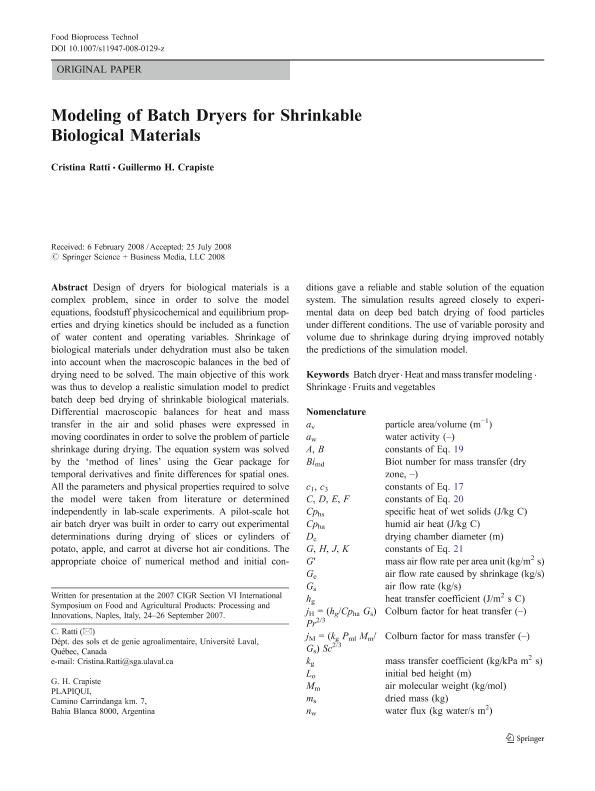Mostrar el registro sencillo del ítem
dc.contributor.author
Ratti, Cristina
dc.contributor.author
Crapiste, Guillermo Hector

dc.date.available
2018-04-16T21:47:59Z
dc.date.issued
2009-09
dc.identifier.citation
Ratti, Cristina; Crapiste, Guillermo Hector; Modeling of Batch Dryers for Shrinkable Biological Materials; Springer; Food and Bioprocess Technology; 2; 3; 9-2009; 248-256
dc.identifier.issn
1935-5130
dc.identifier.uri
http://hdl.handle.net/11336/42234
dc.description.abstract
Design of dryers for biological materials is a complex problem, since in order to solve the model equations, foodstuff physicochemical and equilibrium properties and drying kinetics should be included as a function of water content and operating variables. Shrinkage of biological materials under dehydration must also be taken into account when the macroscopic balances in the bed of drying need to be solved. The main objective of this work was thus to develop a realistic simulation model to predict batch deep bed drying of shrinkable biological materials. Differential macroscopic balances for heat and mass transfer in the air and solid phases were expressed in moving coordinates in order to solve the problem of particle shrinkage during drying. The equation system was solved by the ‘method of lines’ using the Gear package for temporal derivatives and finite differences for spatial ones. All the parameters and physical properties required to solve the model were taken from literature or determined independently in lab-scale experiments. A pilot-scale hot air batch dryer was built in order to carry out experimental determinations during drying of slices or cylinders of potato, apple, and carrot at diverse hot air conditions. The appropriate choice of numerical method and initial conditions gave a reliable and stable solution of the equation system. The simulation results agreed closely to experimental data on deep bed batch drying of food particles under different conditions. The use of variable porosity and volume due to shrinkage during drying improved notably the predictions of the simulation model.
dc.format
application/pdf
dc.language.iso
eng
dc.publisher
Springer

dc.rights
info:eu-repo/semantics/openAccess
dc.rights.uri
https://creativecommons.org/licenses/by-nc-sa/2.5/ar/
dc.subject
Batch Dryer
dc.subject
Heat And Mass Transfer Modeling
dc.subject
Shrinkage
dc.subject
Fruits And Vegetables
dc.subject.classification
Otras Ingeniería Química

dc.subject.classification
Ingeniería Química

dc.subject.classification
INGENIERÍAS Y TECNOLOGÍAS

dc.title
Modeling of Batch Dryers for Shrinkable Biological Materials
dc.type
info:eu-repo/semantics/article
dc.type
info:ar-repo/semantics/artículo
dc.type
info:eu-repo/semantics/publishedVersion
dc.date.updated
2018-04-16T13:35:55Z
dc.journal.volume
2
dc.journal.number
3
dc.journal.pagination
248-256
dc.journal.pais
Alemania

dc.description.fil
Fil: Ratti, Cristina. Laval University; Canadá
dc.description.fil
Fil: Crapiste, Guillermo Hector. Consejo Nacional de Investigaciones Científicas y Técnicas. Centro Científico Tecnológico Conicet - Bahía Blanca. Planta Piloto de Ingeniería Química. Universidad Nacional del Sur. Planta Piloto de Ingeniería Química; Argentina
dc.journal.title
Food and Bioprocess Technology

dc.relation.alternativeid
info:eu-repo/semantics/altIdentifier/url/https://link.springer.com/article/10.1007%2Fs11947-008-0129-z
dc.relation.alternativeid
info:eu-repo/semantics/altIdentifier/doi/http://dx.doi.org/10.1007/s11947-008-0129-z
Archivos asociados
